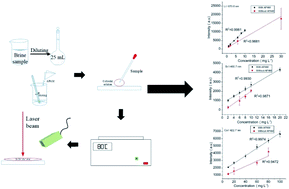Determining metal elements in liquid samples using laser-induced breakdown spectroscopy and phase conversion technology
Abstract
A phase conversion technology, involving the loading of brine samples with anionic polyacrylamide (APAM) colloidal droplets, is proposed to detect metal elements rapidly and accurately in liquid samples using laser-induced breakdown spectroscopy. The experimental conditions were optimized by comparing the obtained emission intensities and the signal-to-noise ratios, including the concentration of APAM, volume ratio of APAM solution to sample, delay time, and lens-to-sample distance (LTSD). Three kinds of complex brine samples with slightly soluble salts were used to test the analytical performance of the proposed method. The results show that the discrepancies of the concentrations of Li, Sr and Ca were 0.74–3.59%, compared with those obtained using inductively coupled plasma-optical emission spectrometry. This suggests that the proposed method can successfully determine metal elements in liquid samples, featuring short sample preparation time (less than 20 min), small sample volume (10 μL), and simple operation (no adsorption).



 Please wait while we load your content...
Please wait while we load your content...